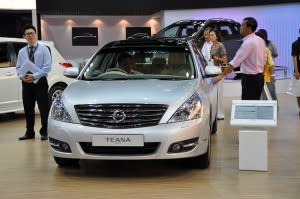4 Changes We Need to Lower COE in Singapore
It’s gotten to the point where, if I sold my soul to the devil, a decent Kia would still be out of the question. Singapore’s car prices are now amongst the highest in the world. And if you need to buy one, I suggest something with a nice back seat. Because you’ll be sleeping in it. But what’s causing the chaos? In this article, we venture an opinion on what needs to be changed:

In Singapore, even our sense of entitlement needs to be certified.
What’s Wrong With the COE?
I knew COE prices couldn’t stay high for long. And I was right…in that it stopped being high and became insanely high.
As of December 2012, small car COEs were up to around $82,000. Open COEs reached about $95,000. That’s enough to buy a small island in Greece (or at the rate things are going, probably Greece itself). According to car dealer Albert Moh, this is:
“…not from a single cause, but an accumulation of factors.
Firstly, the government announced that the car quota was going to shrink at a certain point. This was a sure way to cause the COE prices to spike.
Secondly, it’s a wealth distribution issue. Rich buyers can go ahead and buy three or four cars, and drive up COE prices. If you can afford a BMW or a third car, what can even $92,000 mean to you?
Thirdly, as the prices go up, fewer drivers want to scrap early. So the supply stays tight and bids remain high.”
And that’s the tip of a massive iceberg. But you get the general idea: It’s a tangle of problems causing the spike. And if we’re going to fix it, MoneySmart thinks we need to:
Investigate the role of car companies
Prioritize car buyers
Place a cap on car loans
More telecommuting / flexi-time initiatives
1. Investigate the Role of Car Dealerships

“Whatever it takes. I swear in six weeks, you WILL have this car. Or we’ll both be in prison.”
It’s about time someone looked into car dealerships, and how they’re securing COEs.
Established dealerships can buy COEs by the hundreds, causing huge price movements. But are we scrutinizing them? Nope. We’d rather focus on Ah Huat, and complain when he bids an extra $5,000 for his Impreza.
When bidding for a customer, car dealers tend to be aggressive and bid high. They’re trying to fit the six week time frame, and it’s not their money anyway. Seriously, I don’t know why people let them do this; it’s like giving a five year old your credit card at a candy auction.
But multiply such dealers’ practices a hundredfold (remember, they sell a lot of cars) and it might explain the insane COE prices.
Likewise, it’d be good to know how aggressively dealerships are buying open category COEs. If the dealers know there’s a drop in quota, for example, they can move in and swoop up a few hundred COEs at a snap. This could be the cause of our sudden price spikes.
If we can place restrictions on how many COEs cab companies can buy, maybe we should place some on dealers too.
2. Prioritize Car Buyers

You take that fine back! Bad hair IS a disability!
Currently, COEs (for private cars) are based on engine capacity. I have no doubt this made sense…back when Donald Trump had real hair, and My Sharona was on the top 40.
But coming back to the 2000′s, this system is an antique. We should now divide COEs based on a needs system. In other words, we should have distinct categories or subsidies for:
Parents with two or more children
Families with vulnerable persons (e.g. asthmatic elderly parent must be in range of the hospital)
Disabled persons
First time car buyers
Perhaps in that order.
I’m aware this is a slippery slope. Pretty soon, we’ll have calls for categories like “career needs”, “short stay expats”, and “whining sense of entitlement”. Well this next fact might shock you, but…our government is not famed for its responsiveness.
Trust me, they can draw a line and hold it.
3. Place a Cap on Car Loans

It doesn’t leave the driveway. Once I pay it off, I can afford some petrol.
We need to cap the loan quantum for cars.
At present, you can get 100% financing for a car. This can sometimes be done within the hour, based on the bank involved. That’s unhealthy for a number of reasons:
First, the ease of car loans means we’re putting cars on the road at a breakneck pace. If we can stall the process, by as little as six months to a year, it would make all the difference in fighting road congestion. A good way to do that is just to make people save up longer (60% financing). It would also cool the COE bidding, as overall buyer numbers will drop.
Second, this is the prelude to a debt disaster. As more people buy, the COE prices go higher. And the higher the COE prices climb, the more money car buyers borrow. We’re careful to control debt with casinos and home loans; let’s not ignore $130,000+ car loans.
And speaking of careful loans, follow us on Facebook, and we’ll keep you updated on loan options.
4. More Telecommuting / Flexi-time Initiatives

Pictured: A Singaporean prepares to board the morning train to work.
Oh, you don’t want me to drive? Well Mr. government official, try telling my boss.
Maybe if I didn’t have to rush from Jurong to Changi at six in the morning, I wouldn’t even want to buy a car. Does that ever occur to the officials in charge?
Many Singaporeans only want a car to meet work hours. We’re reluctant to use public transport during the morning rush, since the crowds might cause us to be late. And also, because the train at 8.00am resembles that “Hell of Being Crushed” exhibit at Haw Par Villa.
Consider the advantages of a workforce that telecommutes, or works flexible hours: We’d lower congestion in the Central Business District, diminish rush hour for public transport, and maybe stop buying cars.
All it takes is to channel some funds (say, from the massive COE earnings) into companies. Give small tax cuts to employers that allow flexi-time. For SMEs, subsidize the cost of telecommuting equipment. It would make all the difference in the world.
Image Credits:
blue_quartz, Victor1558, taberandrew, Jason Bagley, Commander, US 7th Fleet
What changes would you make to lower the COE? Comment and let us know!
Get more Personal Finance tips and tricks on www.MoneySmart.sg
Click to Compare Singapore Home Loans, Car Insurance and Credit Cards on our other sites.
More From MoneySmart

 Yahoo Finance
Yahoo Finance 